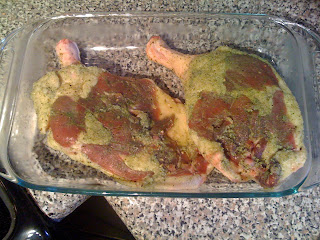I love duck confit. I don't really know the origin of my affinity, but I do know that duck confit is one of the rare dishes that gets a pardon from the no-eating-stuff-you-make-at-home rule when I am eating out at a restaurant. How come? Because it is damn good, that's why. But it's also damn easy to make at home, so you should give it a try.
Two things about this post:
1. All of the photos were taken in my iPhone - sorry if they stink
2. I'm going to leave the confit in the fridge for a while, so this post is simply about cooking the confit, I'll post on how I served it and any tasting notes another time.
Here are two gorgeous Moulard duck leg/thigh pieces that I picked up from Hudson Valley Duck Farm a while back at the NA Market. The guys that run the farm are really interesting folks and while I do have local suppliers for duck in my area (Dr. Joe is less than an hour away), I am planning a trip up to the Hudson Valley this spring to check out their operation...

If you've never made duck confit before, the process is relatively simple. The raw duck is rubbed with a salt/herb/spice mixture and is left to cure in the refrigerator for a period of time. How much time? Keller suggests 24 hours, others say no more than 12 hours - since Keller's curing mixture contains a number of herbs and sugar to balance the salt the longer cure time is ideal. The curing mixture for this recipe includes brown sugar, salt, pepper, bay leaf and thyme. It also include fresh parsley which I was certain I had in the refrigerator.
I didn't.
The fresh parsley would have added a certain moisture to the mix making it more of a paste rather than a damp salt; it also would have added an additional herbaceous quality but, as Donald Rumsfeld said, "You go to war with the army you have -- not the army you might want..." so, I continued on without the parsley.
I put the ingredients into the mini-prep (I love that thing) and processed until the mixture was a uniform consistency:




I did deviate from the recipe slightly; whenever I make duck confit, I always score the top of the duck leg as close to the knobby end as I can safely manage. I have made confit with and without doing this and I find the final result and final presentation to be more appealing by taking the six seconds. You'll see. By the way, I learned to do this as I was flipping channels one Saturday morning last year and I just happened to see a TV chef suggest doing so (I think it was Jacques Pepin - but I don't fully recall). You can see the score marks here:
The green salt is applied to the duck at a rate of one tablespoon of salt per pound of duck - these guys weighed in at right at a pound each:

24 hours later:


Is that a bucket of duck fat? Why yes, yes it is.

The fat is melted, the duck submerged, the lid applied and the pot placed in the oven (how's that for passive voice?!).
The duck is baked, no, braised, no, bathed at a comfortable 190 for several hours. The result? See for yourself:


See what those cuts did for the meat sliding down the leg bone? Nice and clean, just as I wanted. For a more French approach and presentation, the knobs are cut off so just some of the leg bone is showing. I was able to sneak a little taste and this stuff is good - not substantially different than many of the duck confit I have had in the past, but very good. The main difference I notice with this recipe as compared to others I have read and tried in the past is the addition of brown sugar and the lack of more aromatic spices (e.g. star anise and clove) to the curing mix. I only tried a small piece, maybe the difference with this mixture will be more apparent in a larger quantity. The serving options for confit are endless - as part of a salad, as an appetizer with some of the red onion and cranberry marmalade, the base for duck rillettes, and so on and so on...
So let's look at active cooking time:
Making green salt: 4 minutes (to measure, take picture, process in mini prep)
Scoring duck leg and rubbing duck with green salt: 1 minute
Rinsing and drying duck: 3 minutes
Melting duck fat and putting legs in the fatbath: 3 minutes
So with 11 TOTAL minutes of active cooking time you can have a classic French bistro dish that is versatile and delicious. Stop reading and make some. Right now.
Possible additional time commitment:
Putting duck in long-term storage vessel and covering with fat: 5 minutes (which gets you six months of storage time - six months!)
Sources
Duck Legs and Duck Fat from Hudson Valley Duck Farm via NA Market























